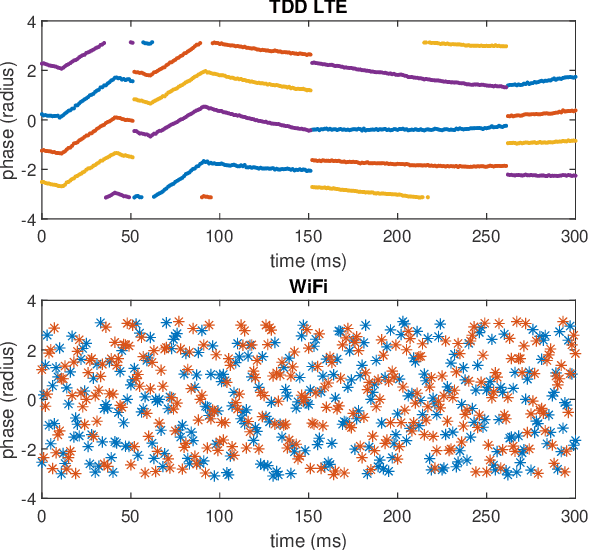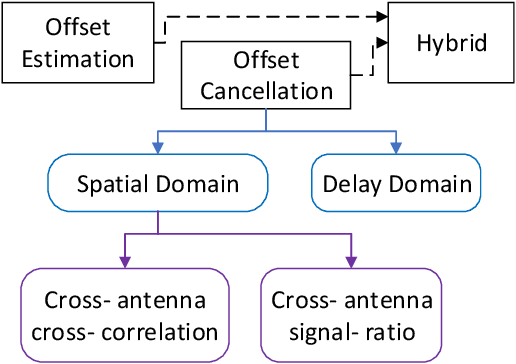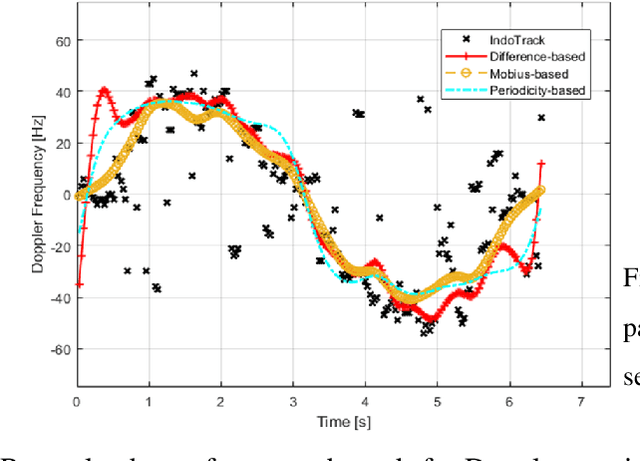Jacopo Pegoraro
LightSNN: Lightweight Architecture Search for Sparse and Accurate Spiking Neural Networks
Mar 27, 2025Abstract:Spiking Neural Networks (SNNs) are highly regarded for their energy efficiency, inherent activation sparsity, and suitability for real-time processing in edge devices. However, most current SNN methods adopt architectures resembling traditional artificial neural networks (ANNs), leading to suboptimal performance when applied to SNNs. While SNNs excel in energy efficiency, they have been associated with lower accuracy levels than traditional ANNs when utilizing conventional architectures. In response, in this work we present LightSNN, a rapid and efficient Neural Network Architecture Search (NAS) technique specifically tailored for SNNs that autonomously leverages the most suitable architecture, striking a good balance between accuracy and efficiency by enforcing sparsity. Based on the spiking NAS network (SNASNet) framework, a cell-based search space including backward connections is utilized to build our training-free pruning-based NAS mechanism. Our technique assesses diverse spike activation patterns across different data samples using a sparsity-aware Hamming distance fitness evaluation. Thorough experiments are conducted on both static (CIFAR10 and CIFAR100) and neuromorphic datasets (DVS128-Gesture). Our LightSNN model achieves state-of-the-art results on CIFAR10 and CIFAR100, improves performance on DVS128Gesture by 4.49%, and significantly reduces search time, most notably offering a 98x speedup over SNASNet and running 30% faster than the best existing method on DVS128Gesture.
Open-Set Gait Recognition from Sparse mmWave Radar Point Clouds
Mar 10, 2025Abstract:The adoption of Millimeter-Wave (mmWave) radar devices for human sensing, particularly gait recognition, has recently gathered significant attention due to their efficiency, resilience to environmental conditions, and privacy-preserving nature. In this work, we tackle the challenging problem of Open-set Gait Recognition (OSGR) from sparse mmWave radar point clouds. Unlike most existing research, which assumes a closed-set scenario, our work considers the more realistic open-set case, where unknown subjects might be present at inference time, and should be correctly recognized by the system. Point clouds are well-suited for edge computing applications with resource constraints, but are more significantly affected by noise and random fluctuations than other representations, like the more common micro-Doppler signature. This is the first work addressing open-set gait recognition with sparse point cloud data. To do so, we propose a novel neural network architecture that combines supervised classification with unsupervised reconstruction of the point clouds, creating a robust, rich, and highly regularized latent space of gait features. To detect unknown subjects at inference time, we introduce a probabilistic novelty detection algorithm that leverages the structured latent space and offers a tunable trade-off between inference speed and prediction accuracy. Along with this paper, we release mmGait10, an original human gait dataset featuring over five hours of measurements from ten subjects, under varied walking modalities. Extensive experimental results show that our solution attains F1-Score improvements by 24% over state-of-the-art methods, on average, and across multiple openness levels.
MovISAC: Coherent Imaging of Moving Targets with Distributed Asynchronous ISAC Devices
Feb 12, 2025Abstract:Distributed integrated sensing and communication (ISAC) devices can overcome the traditional resolution limitations imposed by the signal bandwidth, cooperating to produce high-resolution images of the environment. However, existing phase-coherent imaging approaches are not suited to imaging multiple moving targets, since the Doppler effect causes a phase rotation that degrades the image focus and biases the targets' locations. In this paper, we propose MovISAC, the first coherent imaging method for moving targets using distributed asynchronous ISAC devices. Our approach obtains a set of high-resolution images of the environment, in which each image represents only targets moving with a selected velocity. To achieve this, MovISAC performs over-the-air (OTA) synchronization to compensate for timing, frequency, and phase offsets among distributed ISAC devices. Then, to solve the prohibitive complexity of an exhaustive search over the targets' velocities, we introduce a new association algorithm to match the Doppler shifts observed by each ISAC device pair to the corresponding spatial peaks obtained by standard imaging methods. This gives MovISAC the unique capability of pre-compensating the Doppler shift for each target before forming the images, thus recasting it from an undesired impairment to image formation to an additional means for resolving the targets. We perform extensive numerical simulations showing that our approach achieves extremely high resolution, superior robustness to clutter thanks to the additional target separation in the Doppler domain, and obtains cm- and cm/s-level target localization and velocity estimation errors. MovISAC significantly outperforms existing imaging methods that do not compensate for the Doppler shift, demonstrating up to 18 times lower localization error and enabling velocity estimation.
Using Deep Reinforcement Learning to Enhance Channel Sampling Patterns in Integrated Sensing and Communication
Dec 04, 2024Abstract:In Integrated Sensing And Communication (ISAC) systems, estimating the micro-Doppler (mD) spectrogram of a target requires combining channel estimates retrieved from communication with ad-hoc sensing packets, which cope with the sparsity of the communication traffic. Hence, the mD quality depends on the transmission strategy of the sensing packets, which is still a challenging problem with no known solutions. In this letter, we design a deep Reinforcement Learning (RL) framework that fragments such a problem into a sequence of simpler decisions and takes advantage of the mD temporal evolution for maximizing the reconstruction performance. Our method is the first that learns sampling patterns to directly optimize the mD quality, enabling the adaptation of ISAC systems to variable communication traffic. We validate the proposed approach on a dataset of real channel measurements, reaching up to 40% higher mD reconstruction accuracy and several times lower computational complexity than state-of-the-art methods.
HiSAC: High-Resolution Sensing with Multiband Communication Signals
Jul 09, 2024



Abstract:Integrated Sensing And Communication (ISAC ) systems are expected to perform accurate radar sensing while having minimal impact on communication. Ideally, sensing should only reuse communication resources, especially for spectrum which is contended by many applications. However, this poses a great challenge in that communication systems often operate on narrow subbands with low sensing resolution. Combining contiguous subbands has shown significant resolution gain in active localization. However, multiband ISAC remains unexplored due to communication subbands being highly sparse (non-contiguous) and affected by phase offsets that prevent their aggregation (incoherent). To tackle these problems, we design HiSAC, the first multiband ISAC system that combines diverse subbands across a wide frequency range to achieve super-resolved passive ranging. To solve the non-contiguity and incoherence of subbands, HiSAC combines them progressively, exploiting an anchor propagation path between transmitter and receiver in an optimization problem to achieve phase coherence. HiSAC fully reuses pilot signals in communication systems, it applies to different frequencies and can combine diverse technologies, e.g., 5G-NR and WiGig. We implement HiSAC on an experimental platform in the millimeter-wave unlicensed band and test it on objects and humans. Our results show it enhances the sensing resolution by up to 20 times compared to single-band processing while occupying the same spectrum.
Bistatic Doppler Frequency Estimation with Asynchronous Moving Devices for Integrated Sensing and Communications
Mar 21, 2024



Abstract:In this letter, we present for the first time a method to estimate the bistatic Doppler frequency of a target with clock asynchronous and mobile Integrated Sensing And Communication (ISAC) devices. Existing approaches have separately tackled the presence of phase offsets due to clock asynchrony or the additional Doppler shift due to device movement. However, in real ISAC scenarios, these two sources of phase nuisance are concurrently present, making the estimation of the target's Doppler frequency particularly challenging. Our method solves the problem using the sole wireless signal at the receiver, by computing Channel Impulse Response (CIR) phase differences across different multipath components and subsequent time instants. In this way, we cancel out phase offsets. Then, we construct a system of equations that allows disentangling the target's Doppler frequency from that of the moving device. The proposed method is validated via simulation, exploring the impact of different system parameters. Numerical results show that our approach is a viable way of estimating Doppler frequency in bistatic asynchronous ISAC scenarios with mobile devices.
Sensing in Bi-Static ISAC Systems with Clock Asynchronism: A Signal Processing Perspective
Feb 14, 2024



Abstract:Integrated Sensing and Communications (ISAC) has been identified as a pillar usage scenario for the impending 6G era. Bi-static sensing, a major type of sensing in \ac{isac}, is promising to expedite ISAC in the near future, as it requires minimal changes to the existing network infrastructure. However, a critical challenge for bi-static sensing is clock asynchronism due to the use of different clocks at far separated transmitter and receiver. This causes the received signal to be affected by time-varying random phase offsets, severely degrading, or even failing, direct sensing. Considerable research attention has been directed toward addressing the clock asynchronism issue in bi-static sensing. In this white paper, we endeavor to fill the gap by providing an overview of the issue and existing techniques developed in an ISAC background. Based on the review and comparison, we also draw insights into the future research directions and open problems, aiming to nurture the maturation of bi-static sensing in ISAC.
Learned Spike Encoding of the Channel Response for Low-Power Environment Sensing
Jan 29, 2024Abstract:Radio Frequency (RF) sensing holds the potential for enabling pervasive monitoring applications. However, modern sensing algorithms imply complex operations, which clash with the energy-constrained nature of edge sensing devices. This calls for the development of new processing and learning techniques that can strike a suitable balance between performance and energy efficiency. Spiking Neural Networks (SNNs) have recently emerged as an energy-efficient alternative to conventional neural networks for edge computing applications. They process information in the form of sparse binary spike trains, thus potentially reducing energy consumption by several orders of magnitude. Their fruitful use for RF signal processing critically depends on the representation of RF signals in the form of spike signals. We underline that existing spike encoding algorithms to do so generally produce inaccurate signal representations and dense (i.e., inefficient) spike trains. In this work, we propose a lightweight neural architecture that learns a tailored spike encoding representations of RF channel responses by jointly reconstructing the input and its spectral content. By leveraging a tunable regularization term, our approach enables fine-grained control over the performance-energy trade-off of the system. Our numerical results show that the proposed method outperforms existing encoding algorithms in terms of reconstruction error and sparsity of the obtained spike encodings.
An Experimental Prototype for Multistatic Asynchronous ISAC
Oct 01, 2023Abstract:We prototype and validate a multistatic mmWave ISAC system based on IEEE802.11ay. Compensation of the clock asynchrony between each TX and RX pair is performed using the sole LoS wireless signal propagation. As a result, our system provides concurrent target tracking and micro-Doppler estimation from multiple points of view, paving the way for practical multistatic data fusion. Our results on human movement sensing, complemented with precise, quantitative GT data, demonstrate the enhanced sensing capabilities of multistatic ISAC, due to the spatial diversity of the receiver nodes.
Enhanced Attention-Based Unrolling for Sparse Sequential micro-Doppler Reconstruction
Jun 25, 2023Abstract:The reconstruction of micro-Doppler signatures of human movements is a key enabler for fine-grained activity recognition with radio-frequency sensing. In this work, we focus on Joint Communication and Sensing (JCS) systems where, unlike in dedicated radar sensing systems, a suitable tradeoff between sensing accuracy and communication overhead has to be attained. It follows that the micro-Doppler has to be reconstructed from sparse and noisy channel estimates obtained from communication packets, limiting as much as possible the transmission of additional probing signals for the purpose of sensing. Existing approaches exploit compressed sensing, but produce very poor reconstructions when only a few channel measurements are available, which is often the case in real communication patterns. In addition, the large number of iterations they need to converge hinders their use in real-time systems. Here, we present STAR, a lightweight neural network that combines a single unrolled iterative hard-thresholding layer with an attention mechanism. Our new approach exploits the temporal correlation of the micro-Doppler to accurately reconstruct microDoppler sequences from human movement even from very sparse channel measurements. In doing so, it combines model-based and data-driven approaches into an interpretable and low-complexity architecture, which is amenable to real-time implementations. We evaluate STAR on a public JCS dataset of 60 GHz IEEE 802.11ay channel measurements of human activity traces. Experimental results show that it substantially outperforms state-of-the-art solutions in terms of the reconstructed microDoppler quality. Remarkably, STAR enables human activity recognition with satisfactory accuracy even with 90%-sparse channel measurements, for which existing techniques fail.
 Add to Chrome
Add to Chrome Add to Firefox
Add to Firefox Add to Edge
Add to Edge